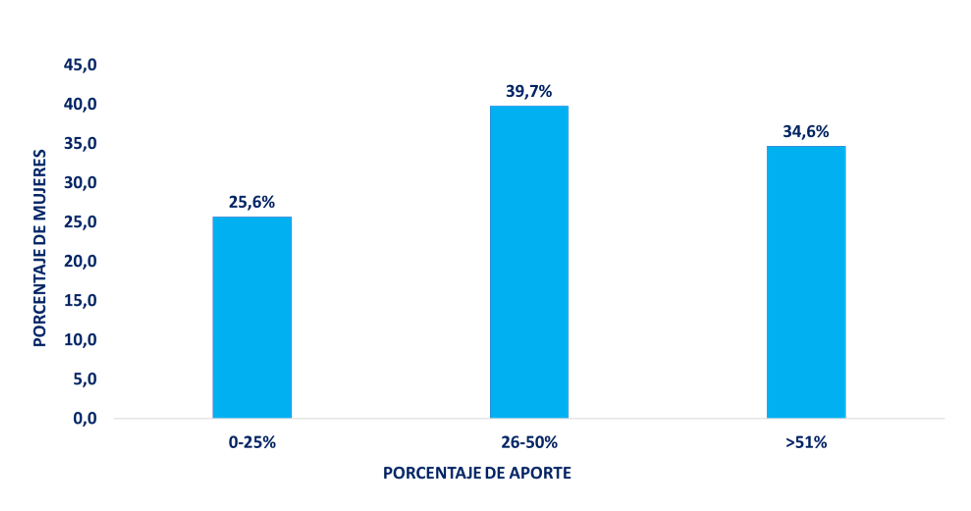Mujer rural arrocera y su aporte económico en el caribe húmedo colombiano
Main Article Content
Resumo
Las mujeres rurales enfrentan desafíos y desigualdades en relación con el acceso a recursos, tierra, educación y oportunidades económicas, así como en el reconocimiento y la valoración de su papel en la economía rural. De ahí que resulte fundamental fomentar la equidad de género para el desarrollo sostenible en las comunidades rurales. En este sentido, el presente estudio se realizó con el propósito de identificar la contribución económica de las mujeres productoras de arroz en el Caribe Húmedo Colombiano, apoyando la investigación en un método mixto con enfoque cualitativo y cuantitativo. La mujer agricultora arrocera evidenció ser resiliente ante situaciones fortuitas; un 74.3% de las mujeres encuestadas aportan la mitad o totalidad de sus ganancias económicas; toman decisiones en el hogar y en su actividad arrocera de igual forma que los hombres; también se evidencia el deficiente apoyo del sector financiero en este gremio. Se constató el arraigo que las mujeres agricultoras tienen por la tierra, de este modo, estas son responsables, en gran medida, de la producción de arroz, aportando a la seguridad alimentaria de sus hogares y a una mejor calidad de vida.
Article Details

Este trabalho encontra-se publicado com a Creative Commons Atribuição-NãoComercial 4.0.
Los autores que publican en esta revista están de acuerdo con los siguientes términos:
- Los autores conservan los derechos de autor y garantizan a la revista el derecho de ser la primera publicación del trabajo al igual que licenciado bajo unaCreative Commons Attribution-NonCommercial 4.0 Unported License esto significa que se permite su copia y distribución por cualquier medio, siempre que se mantenga el reconocimiento de sus autores y no se haga uso comercial de las obras. El envio de manuscritos, el procesamiento y la publicación no ofrecen ningún coste a los autores, es totalmente gratis.

This journal is licensed under a Creative Commons Attribution-NonCommercial 4.0 Unported License.
Referências
Abubarak, R; Gershom, E; Qasir, A; Xu, T y Rafay, W. (2020). Women participation: A Productivity Strategy in Rice Production. Sustainability. DOI: http://doi.org/10.3390/su12072870
Bedoya, M y Velásquez, L. 2020. Un análisis de las condiciones socioeconómicas y participación laboral de la mujer rural en Colombia. Universidad EAFIT. Obtenido de: https://repository.eafit.edu.co/bitstream/handle/10784/16793/Mariana_BedoyaJaramillo_Lisdey_VelasquezCorrea_2020.pdf?sequence=2
Botello, H. y Guerrero, I. (2017). Condiciones para el empoderamiento de la mujer rural en Colombia. Revista Entramado. Vol. 13. No. I. Pág. 62-70. http://www.scielo.org.co/pdf/entra/v13n1/1900-3803-entra-13-01-00062.pdf
Bravo, P y del Rosario, M. (2011). Seminario Internacional Mujer Rural: Cambios y Persistencias en América Latina. Centro peruano de estudios sociales (CEPES). 36 p. http://www.americalatina.landcoalition.org/sites/default/files/libro%20Mujer%20Rural.pdf
FAO. 2023. Mujeres rurales emprendedoras: empoderamiento económico para poner fin a las violencias. Palabras disponibles desde: https://www.fao.org/colombia/programas-y-proyectos/historias-de-exito/mujer-rural-1/es/ [4, agosto, 2023].
Inamoto, A. 2018. Género y cambio climático: experiencias, percepciones y adaptaciones de arroceras y arroceros en Tolima, Colombia. Revista Arroz. Vol. 66. No.534. Pág. 22-27. https://sioc.minagricultura.gov.co/DocumentosContexto/S3396-arroz534.pdf
Mogollón, P. (2020). La mujer en el cultivo de arroz en Colombia. Revista Arroz. Vol. 68, No. 545, Pág. 4-8. https://fedearroz.s3.amazonaws.com/media/documents/Revista_545.pdf
Molina, E y Victorero, E. (2015). La agricultura en países subdesarrollados. Particularidades de su financiamiento. CLACSO. La Habana. https://core.ac.uk/download/pdf/35230323.pdf
OIT. (2007). Fomento de la autonomía de la mujer en la economía rural. Notas de orientación de políticas. 14 p. https://www.ilo.org/wcmsp5/groups/public/---ed_dialogue/---sector/documents/publication/wcms_601269.pdf
ONU. (2022). Mujeres rurales. Empoderamiento económico. Las palabras disponibles desde: https://www.unwomen.org/es/what-we-do/economicempowerment/ruralwomen . [04, agosto, 2023].
Pagés, C. y Piras, C. (2010). El Dividendo de Género: cómo Capitalizar el Trabajo de las Mujeres. Banco Interamericano de Desarrollo (BID). Washington, D.C. 45 p. https://publications.iadb.org/publications/spanish/viewer/El-dividendo-de-g%C3%A9nero-C%C3%B3mo-capitalizar-el-trabajo-de-las-mujeres.pdf
PNUD. (2012). La mujer rural y los Objetivos de Desarrollo del Milenio. [Folleto]. Obtenido de: https://cedla.org/wp-content/uploads/attachments/mujerruralyODM.pdf
Ramírez, D. (2011). Productividad agrícola de la mujer rural en Centroamérica y México. Comisión Económica para América Latina y el Caribe (CEPAL). Naciones Unidas. 51 p. https://repositorio.cepal.org/bitstream/handle/11362/26078/S2011148_es.pdf?sequence=1&isAllowed=y
Ranaboldo, C. (2018). Enfoque territorial para el empoderamiento de las mujeres rurales: análisis y propuestas desde América Latina. ONU Mujeres. 22 p. https://lac.unwomen.org/sites/default/files/Field%20Office%20Americas/Documentos/Publicaciones/2018/5/Enfoque%20territorial_ONU%20Mujeres.pdf
Segovia, O y Williner, A. (2016). Territorio e igualdad. Planificación del desarrollo con perspectiva de género. Comisión Económica para América Latina y el Caribe (CEPAL). Naciones Unidas, Santiago. 82 p. https://repositorio.cepal.org/bitstream/handle/11362/40665/1/S1601000_es.pdf
